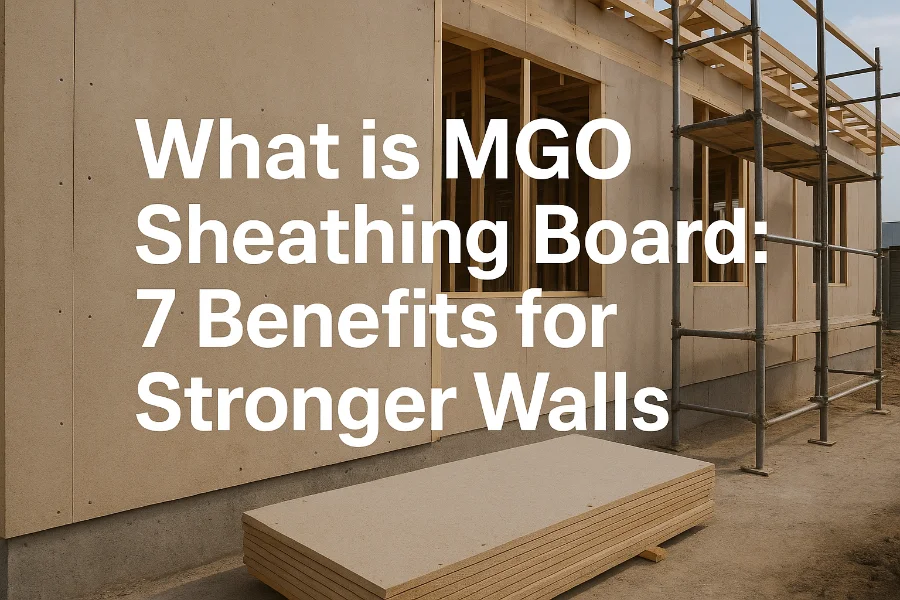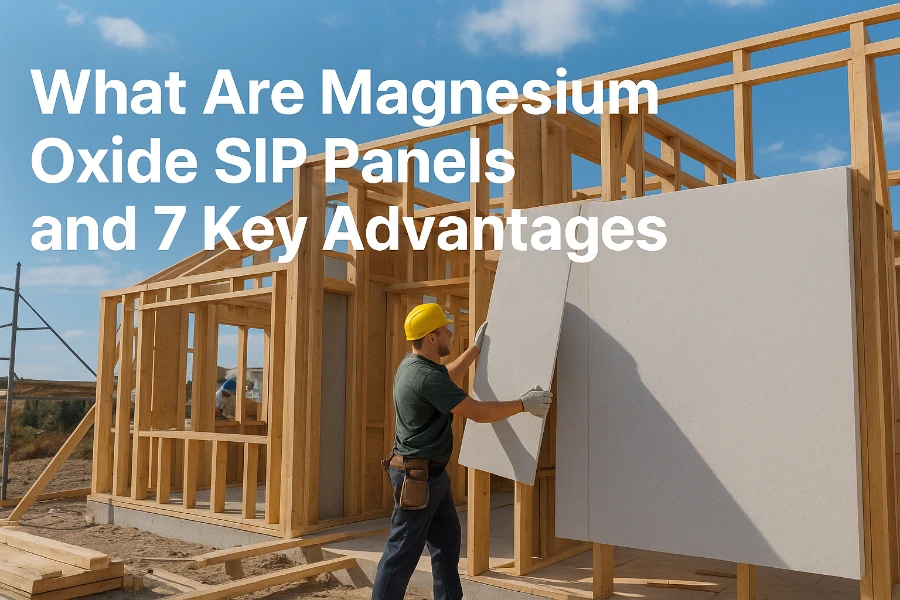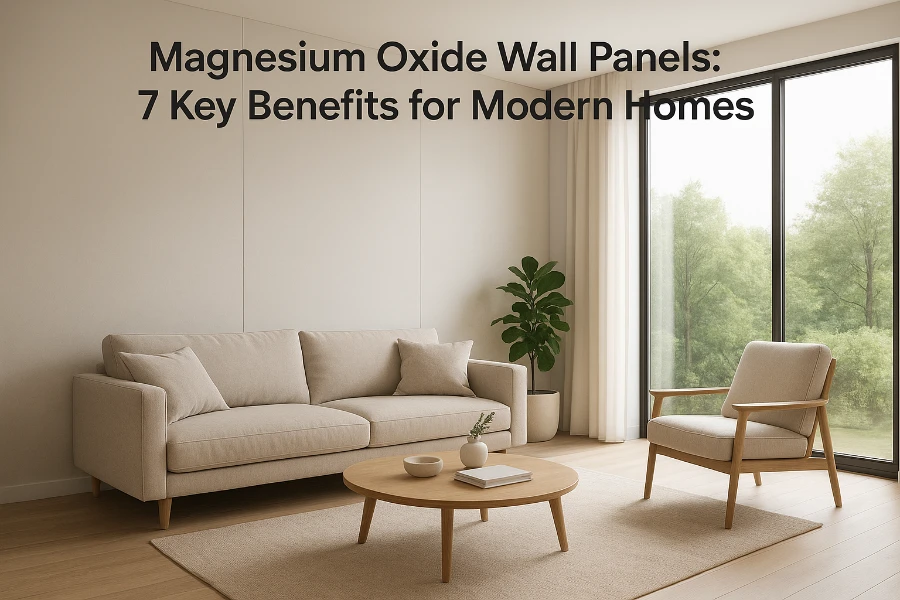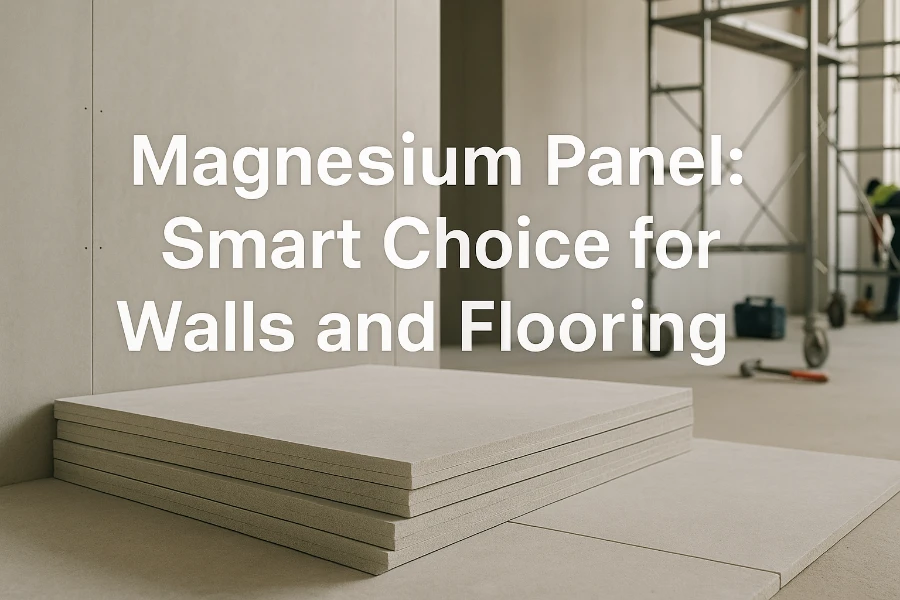Table of Contents
Introduction
In today’s fast-paced construction industry, choosing the right building materials can make a significant difference in both the quality and longevity of a project. One material that has gained remarkable attention among architects, contractors, and builders is the MGO sheathing board. Known for its superior durability, fire resistance, and eco-friendliness, this innovative building board has become a preferred choice for modern constructions seeking long-term performance.
Unlike traditional sheathing materials such as plywood or gypsum board, MGO sheathing boards are made from magnesium oxide, a naturally occurring mineral, which gives them unique properties that meet the increasingly demanding standards of today’s construction projects. Builders are now prioritizing materials that not only deliver structural stability but also provide added safety and environmental benefits.
This article aims to give a comprehensive guide on what MGO sheathing board is and why it has emerged as a game-changer in the building materials sector. We will explore its seven key benefits, ranging from fire resistance to versatile applications, while also highlighting practical tips for choosing the right board for your project. By the end of this guide, you will understand why MGO sheathing board is not just an alternative, but a smart investment for stronger, safer, and more sustainable buildings.
What is MGO Sheathing Board?
MGO sheathing board—short for Magnesium Oxide sheathing board—is an advanced construction material designed to offer strength, safety, and versatility. Composed primarily of magnesium oxide (MgO), magnesium sulfate (MgSO4), and various reinforcing additives such as fiberglass mesh, MGO boards are engineered to outperform conventional sheathing materials like plywood, OSB, and gypsum boards in multiple aspects.
Composition and Manufacturing
MGO sheathing boards are manufactured through a chemical reaction between magnesium oxide and magnesium sulfate, which forms a dense, cement-like structure. This process creates a board that is not only lightweight but also resistant to fire, moisture, mold, and impact. Additionally, some manufacturers incorporate fibers or other reinforcing agents to enhance structural integrity and flexibility, making the boards suitable for a wide range of applications.
Comparison with Traditional Materials
Unlike plywood, which is prone to warping and termite attacks, or gypsum boards, which can deteriorate in humid conditions, MGO sheathing board offers superior performance under extreme conditions. It maintains its shape, strength, and protective qualities even in high humidity or heat, which makes it especially valuable in regions prone to fires or moisture-related issues. Furthermore, its non-combustible nature gives it a significant edge over conventional boards, which can contribute to building fires spreading quickly.
Key Features That Make MGO Boards Stand Out
-
Fire Resistance – MGO boards are non-combustible and can withstand high temperatures without degrading.
-
Moisture Resistance – Unlike gypsum, MGO boards resist water penetration and do not swell or deteriorate when exposed to moisture.
-
Durability – Their cement-like structure ensures long-lasting performance with minimal maintenance.
-
Eco-Friendly – Made from natural minerals and non-toxic additives, they are safer for both builders and occupants.
-
Versatility – Suitable for interior and exterior walls, ceilings, and sub-flooring, adaptable to many construction projects.
Overall, MGO sheathing board is more than just a replacement for traditional sheathing materials. Its combination of safety, durability, and eco-friendliness positions it as a smart choice for modern construction projects that prioritize quality, sustainability, and long-term performance.
1. Fire Resistance
One of the most critical advantages of MGO sheathing board is its outstanding fire resistance. In modern construction, fire safety is not just a regulatory requirement—it is a vital factor in protecting lives, property, and investments. Unlike conventional sheathing materials such as plywood or gypsum board, which are flammable and can accelerate fire spread, MGO boards are non-combustible. They can withstand temperatures exceeding 1,200°C (2,192°F) without catching fire, making them ideal for both residential and commercial buildings.
How MGO Boards Resist Fire
The secret behind the fire resistance of MGO boards lies in their mineral composition. Magnesium oxide, a naturally occurring mineral, has a high melting point and does not emit toxic fumes when exposed to fire. When incorporated into a board with magnesium chloride and reinforcing fibers, the material forms a dense, stable matrix that slows down heat transfer. This property helps in containing fire within a localized area and provides crucial extra minutes for evacuation and emergency response.
Standards and Certifications
Many MGO sheathing boards are tested and certified according to international fire safety standards, including ASTM E119, EN 13501-1, and ISO fire-resistance tests. These certifications ensure that the boards perform reliably under extreme fire conditions and meet the rigorous safety requirements for building codes worldwide. Using certified MGO boards demonstrates a commitment to safety and can also improve the overall insurance rating of a building.
Real-World Applications
The fire-resistant properties of MGO boards make them highly suitable for various applications:
-
Residential buildings: Protecting walls and ceilings in homes to reduce fire hazards.
-
Commercial spaces: Office buildings, shopping malls, and hotels benefit from non-combustible wall sheathing.
-
Industrial facilities: Warehouses and factories where high-temperature exposure is possible.
-
Public infrastructure: Schools, hospitals, and airports where fire safety is paramount.
In short, incorporating MGO sheathing board into construction projects provides peace of mind for builders and occupants alike. Its ability to resist fire effectively reduces risks, enhances safety, and supports compliance with modern building standards.
2. Moisture and Mold Resistance
Another significant advantage of MGO sheathing board is its exceptional moisture and mold resistance. Moisture-related issues, such as warping, swelling, or mold growth, are common problems in traditional building materials like plywood and gypsum boards. Over time, these issues can compromise structural integrity and create unhealthy indoor environments. MGO boards, however, are specifically engineered to resist moisture absorption, making them a reliable choice for both interior and exterior applications.
Moisture-Proof Properties
MGO sheathing boards have a dense, non-porous structure that prevents water from penetrating the material. Even in high-humidity areas or regions with frequent rainfall, these boards maintain their shape and strength. Unlike conventional gypsum boards, which can deteriorate when exposed to moisture, MGO boards do not swell or crumble. This property makes them ideal for use in bathrooms, kitchens, basements, or coastal buildings where moisture levels are high.
Anti-Mold and Anti-Fungal Advantages
Mold and fungi thrive in damp environments, posing risks to both building materials and occupants’ health. MGO boards are naturally resistant to mold growth due to their alkaline nature and low water absorption. This resistance helps prevent the development of musty odors, allergic reactions, or respiratory issues often associated with mold contamination. For builders and property owners, this translates into lower maintenance costs and a healthier indoor environment.
Benefits for Building Longevity
Using MGO sheathing board in moisture-prone areas extends the life of the construction significantly. Buildings with MGO boards experience fewer repair and replacement needs, which reduces overall maintenance expenses. Additionally, the boards’ resistance to both moisture and mold contributes to sustainable construction practices, as fewer resources are wasted on replacing damaged materials.
Practical Applications
-
Bathrooms and kitchens: Walls and ceilings that endure high humidity without damage.
-
Sub-flooring: Prevents moisture-related warping under flooring installations.
-
Coastal and high-rainfall regions: Reliable protection against environmental moisture.
In summary, the moisture and mold resistance of MGO sheathing boards makes them a smart choice for modern constructions, ensuring both durability and healthy living spaces.
3. Durability and Strength
When it comes to long-lasting construction, durability and strength are non-negotiable qualities. MGO sheathing board excels in both areas, providing builders and homeowners with a material that withstands the test of time while maintaining structural integrity under demanding conditions.
Mechanical Strength and Load-Bearing Capacity
MGO boards are renowned for their high mechanical strength. Thanks to the chemical reaction between magnesium oxide and magnesium chloride, the boards form a dense, cement-like structure that can support substantial loads without cracking or breaking. This makes them highly suitable for use in load-bearing walls, sub-flooring, and ceilings where traditional materials may falter. Compared to plywood or gypsum boards, MGO boards offer superior rigidity and structural support, reducing the risk of sagging or deformation over time.
Impact Resistance
Another key strength of MGO sheathing board is its impact resistance. The reinforced composition, often including fiberglass mesh or other fibers, allows the boards to absorb shocks without sustaining significant damage. This makes them ideal for high-traffic areas, commercial spaces, and environments where accidental impacts are likely, such as schools, hospitals, and offices. Unlike gypsum boards that can easily chip or crack, MGO boards maintain their integrity, ensuring the longevity of walls and ceilings.
Comparison with Plywood and Gypsum Boards
-
Plywood: While plywood is relatively strong, it is susceptible to water damage, termites, and warping. Its fire resistance is also limited.
-
Gypsum Board: Gypsum boards are lightweight and easy to install, but they lack durability under heavy loads and can be compromised by moisture.
-
MGO Sheathing Board: Combines fire resistance, moisture resistance, and high structural strength, providing a superior alternative for both interior and exterior construction.
Long-Term Advantages
Investing in MGO sheathing board means fewer repairs and replacements over the life of a building. Its durable composition ensures that walls, ceilings, and floors remain intact and functional for decades, even in challenging environmental conditions. This longevity translates into cost savings for builders and homeowners, while also enhancing the property’s resale value.
Practical Applications
-
Residential buildings: Provides strong and long-lasting interior and exterior walls.
-
Commercial constructions: Supports ceilings and walls in offices, malls, and public spaces.
-
Industrial environments: Resistant to impact and wear, ideal for factories or warehouses.
In essence, the durability and strength of MGO sheathing boards make them a reliable cornerstone of modern construction, delivering long-term performance that traditional materials struggle to match.

4. Eco-Friendliness
Sustainability has become a major focus in the construction industry, and MGO sheathing board stands out as an eco-friendly alternative to traditional building materials. Its production, composition, and end-of-life disposal all contribute to reduced environmental impact, making it an ideal choice for green building projects.
Non-Toxic and Sustainable Materials
Unlike many conventional boards that contain formaldehyde, adhesives, or other harmful chemicals, MGO sheathing boards are made primarily from natural magnesium oxide and magnesium chloride, with minimal additives. This ensures that the boards are non-toxic, safe for indoor environments, and suitable for spaces occupied by children, the elderly, or people with respiratory sensitivities.
Low Environmental Impact in Production
The production of MGO boards is relatively energy-efficient compared to gypsum or cement boards. It uses abundant natural minerals and generates fewer greenhouse gas emissions. Additionally, the lightweight nature of the boards reduces transportation energy costs, further decreasing the overall carbon footprint.
Contribution to Green Building Certifications
Using MGO sheathing board can help projects achieve environmental certifications such as LEED (Leadership in Energy and Environmental Design) or BREEAM (Building Research Establishment Environmental Assessment Method). Its renewable material composition, durability, and low chemical emissions align with the criteria required for sustainable construction, giving builders and developers a competitive edge in green building markets.
Recyclability and Disposal
At the end of its service life, MGO boards can be recycled or safely disposed of without releasing harmful substances into the environment. Unlike traditional boards that may contain synthetic resins or chemicals that contaminate landfills, MGO boards contribute to circular construction practices, supporting sustainability goals in the building sector.
Practical Benefits
-
Healthier indoor air: Reduced chemical emissions improve indoor air quality.
-
Environmental responsibility: Projects using MGO boards demonstrate commitment to sustainability.
-
Cost-effectiveness in the long term: Durable, low-maintenance boards reduce the need for replacements, indirectly saving resources.
In summary, the eco-friendliness of MGO sheathing board not only benefits the environment but also adds value to construction projects through healthier spaces, sustainability credentials, and alignment with modern green building standards.
5. Easy Installation
Another key advantage of MGO sheathing board is its ease of installation, which saves both time and labor costs on construction projects. Its user-friendly properties make it a preferred choice for builders and contractors seeking efficiency without compromising quality.
Lightweight and Versatile
Despite its strength and durability, MGO sheathing board is relatively lightweight compared to cement or fiber-cement boards. This makes it easier to handle on-site, reducing physical strain for workers and allowing for faster installation. Its versatile sizes and thickness options also enable it to fit various construction needs, from walls and ceilings to sub-flooring.
Compatibility with Standard Tools and Fasteners
MGO boards are compatible with standard construction tools, including saws, drills, and screwdrivers. They can be easily cut, drilled, and fixed using conventional fasteners such as screws or nails. This eliminates the need for specialized equipment, lowering installation costs and simplifying logistics on-site.
Reduced Labor Time and Costs
Because of their lightweight nature and easy workability, MGO sheathing boards can be installed more quickly than traditional materials like plywood or gypsum board. This not only accelerates project timelines but also reduces labor expenses, which is particularly valuable for large-scale commercial projects. Faster installation also minimizes disruption in occupied spaces, such as schools or hospitals, where downtime can be costly.
Practical Applications
-
Residential walls and ceilings: Quick and precise installation for home renovations or new builds.
-
Commercial projects: Large-scale office or retail space installations benefit from time efficiency.
-
Retrofit and renovation projects: Ideal for upgrading existing structures without extensive demolition.
In conclusion, the easy installation of MGO sheathing board enhances construction efficiency, reduces costs, and allows builders to complete projects faster without sacrificing performance or durability.
6. Sound Insulation
In modern construction, acoustic comfort is increasingly valued, whether in residential, commercial, or public spaces. MGO sheathing board offers excellent sound insulation properties, making it a practical solution for reducing noise and creating more comfortable indoor environments.
Acoustic Properties
The dense, cement-like structure of MGO boards naturally dampens sound transmission, helping to block external noise and minimize sound leakage between rooms. Unlike lightweight gypsum boards, which may allow more noise to pass through, MGO boards provide a more substantial barrier, ensuring quieter, more peaceful interiors.
Applications in Residential and Commercial Buildings
-
Residential spaces: MGO boards can be used for walls and ceilings in apartments, houses, and multi-unit dwellings to prevent sound disturbance from neighbors or traffic.
-
Commercial offices: Offices benefit from reduced noise between meeting rooms or open-plan areas, improving concentration and productivity.
-
Hotels and hospitality: Quiet environments enhance guest satisfaction and comfort.
-
Public buildings: Schools, hospitals, and libraries can create better acoustic environments for learning, healing, or studying.
Additional Benefits
-
Enhanced privacy: Reduces sound transmission, maintaining privacy between rooms or units.
-
Energy efficiency: Dense boards also provide slight thermal insulation, contributing to overall energy savings.
-
Integration with other acoustic systems: MGO boards can work alongside insulation materials and acoustic panels for optimized soundproofing solutions.
Overall, the sound insulation capability of MGO sheathing board makes it a versatile choice for projects where acoustic performance is essential, providing both comfort and functionality.
7. Versatility in Applications
One of the standout features of MGO sheathing board is its remarkable versatility. Its combination of durability, fire resistance, moisture resistance, and ease of installation allows it to be used in a wide variety of construction projects, from residential homes to large commercial complexes.
Interior Walls and Ceilings
MGO boards are ideal for interior walls and ceilings, offering a smooth, durable surface that can be painted, wallpapered, or tiled. Their fire resistance and sound insulation properties make them especially valuable in multi-story buildings, where safety and comfort are paramount.
Sub-Flooring
Thanks to their strength and moisture resistance, MGO boards are perfect for sub-flooring applications. They provide a stable base for tiles, vinyl, or laminate flooring, while also preventing issues like swelling, warping, or mold growth that are common with traditional boards.
Exterior Sheathing
In addition to interior uses, MGO boards can serve as exterior sheathing, providing structural support and an additional layer of fire and moisture protection. This makes them suitable for walls in regions with harsh weather conditions, including high rainfall or coastal areas.
Integration with Other Materials
MGO sheathing boards are compatible with a variety of finishing materials, such as plaster, cement render, or decorative panels. Their flat, stable surface ensures easy bonding and reduces the risk of cracks or delamination, making them highly adaptable to different design requirements.
Customization Options
Manufacturers often provide MGO boards in multiple thicknesses, sizes, and finishes, allowing builders to choose the right board for specific applications. This flexibility ensures that MGO boards can meet both standard and specialized construction needs, whether for residential, commercial, or industrial projects.
In summary, the versatility of MGO sheathing board makes it a go-to material for modern construction, providing reliable performance across a broad range of applications and enabling builders to create safer, stronger, and more sustainable structures.
How to Choose the Right MGO Sheathing Board
Selecting the appropriate MGO sheathing board is crucial to ensure optimal performance, durability, and safety in any construction project. With various grades, thicknesses, and sizes available, understanding key considerations can help builders make the best choice.
Thickness, Size, and Grade Considerations
MGO boards come in different thicknesses, typically ranging from 6mm to 20mm, and various standard sizes such as 1220mm × 2440mm. Thicker boards provide better structural support, fire resistance, and sound insulation, making them suitable for sub-flooring or exterior walls. Thinner boards, on the other hand, are easier to handle and ideal for interior walls or ceilings.
The grade of MGO board also matters. High-grade boards are reinforced for maximum strength and durability, while standard grades may be sufficient for general interior applications. Selecting the right grade ensures the board performs according to project requirements.
Supplier Selection Tips
Choosing a reputable supplier is essential to guarantee product quality. Look for manufacturers with certifications that meet international standards, such as ASTM, ISO, or EN certifications. Reliable suppliers often provide technical support, installation guidance, and consistent board quality, reducing the risk of issues during construction.
Cost vs. Performance Analysis
While MGO sheathing boards may have a higher initial cost than plywood or gypsum boards, their long-term benefits—including fire safety, durability, moisture resistance, and low maintenance—often outweigh the upfront investment. Consider the total cost of ownership, which includes installation, maintenance, and replacement expenses, rather than just the purchase price.
Practical Tips
-
Assess environmental conditions: moisture, fire risk, and temperature extremes.
-
Match board thickness and grade to specific applications.
-
Verify supplier credentials and certifications.
-
Balance upfront costs with long-term durability and safety benefits.
By carefully selecting the right MGO sheathing board, builders can ensure maximum performance, safety, and value for their projects, creating structures that stand the test of time.
Conclusion
In summary, MGO sheathing board is a versatile, durable, and eco-friendly building material that offers numerous advantages over traditional sheathing options. From fire resistance and moisture protection to sound insulation, easy installation, and long-lasting strength, these boards address the key challenges faced in modern construction. Their natural composition and environmental benefits make them a smart choice for sustainable building projects, while their versatility allows application in walls, ceilings, sub-flooring, and exterior sheathing.
By understanding the 7 key benefits of MGO sheathing boards, builders, architects, and homeowners can make informed decisions that enhance safety, durability, and overall project performance. Whether you are constructing a new home, upgrading commercial spaces, or working on large-scale industrial projects, MGO sheathing board offers a reliable, high-performance solution.
Ready to upgrade your construction projects with MGO sheathing boards? Contact us today to learn more about our high-quality boards, sizes, and grades that fit your specific needs. Our team is here to provide expert guidance and support, ensuring your projects are built stronger, safer, and more sustainably.
Discover what are magnesium oxide SIP panels and the 7 key advantages, from fire resistance to durability, and eco-friendly building solutions.
Discover 7 key benefits of magnesium oxide wall panels for modern homes, from fire resistance and moisture protection to durability and eco-friendliness.
Magnesium panel is a smart choice for walls and flooring, offering fire resistance, moisture protection, and versatile applications for modern construction.




